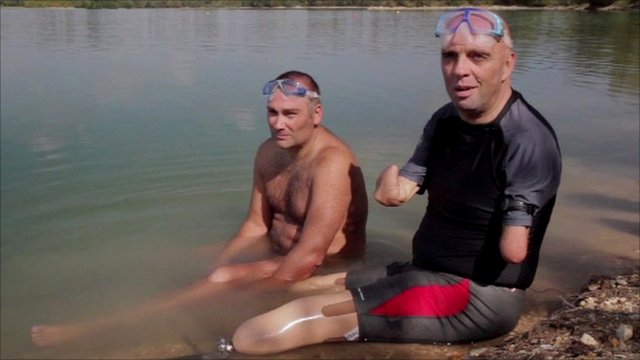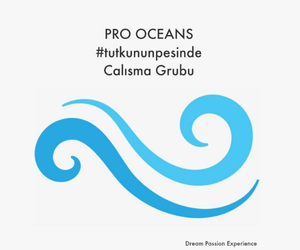Most days, Philippe Croizon and Arnaud Chassery are ploughing the waters of their local boating lake, training for their next big challenge.
But beneath the waterline, they are very different. Philippe has no arms and no legs.
Seventeen years ago, while adjusting a television aerial on a roof, the former steel worker was given an electric shock by an overhead power line.
When they amputated my last limb, the left leg, I wanted to die. I was so depressed, as low as you can get. But you have to make a decision – and I chose to live”
Philippe Croizon
An electric charge of 20,000 volts fused him to the metal ladder on which he was standing.
He would have been killed instantly – but another thunderous charge snapped him back to life. By the time help arrived, he was so grievously burned that both his arms and his legs had to be removed.
“When they amputated my last limb, the left leg, I wanted to die,” he said. “I was so depressed, as low as you can get. But you have to make a decision – and I chose to live.”
He says he was inspired to swim while in hospital. He saw a documentary on television about an Englishwoman who had swum the English Channel earlier that year.
“Wow, I thought. Why can’t I do that? Why can’t I swim the Channel? I don’t know why but it became an obsession,” said Philippe.
Fourteen years later, the 43-year-old became the first limbless man to cross the 34km (21-mile) Channel between France and England – a feat that has only been achieved by some 900 other, able-bodied, swimmers.
He crossed from Folkestone to Cap Gris Nez in 13 hours, 23 minutes – well ahead of his 20-hour target.
Precious partnerships
Now, he and fellow Channel swimmer Arnaud plan to swim four further straits between five continents.
Arnaud Chassery and Philippe Croizon prepare to enter the water Arnaud Chassery and Philippe Croizon prepare to enter the water
Next year, the pair will attempt to cross: the icy Bering Strait between Alaska and Russia; the shark-infested Gulf of Aqaba between Asia and Africa; and the straits between Gibraltar and Morocco, and between Papua New Guinea and Indonesia.
Philippe is surrounded by loving and devoted people including his partner, Suzana, whom he met through the internet.
She drives him to training and is always there to assist with some of the more mundane things Philippe cannot manage.
But by the lake, it is Arnaud who takes over.
On the edge of the jetty, Philippe raises the stumps of his legs onto which Arnaud gently slides a pair of silicone protective sleeves. Then he fits Philippe’s plastic, fibre-glass thigh extensions. They are each specially adapted to hold the large blue flippers that propel him through the water.
Once he is “dressed”, Arnaud wheels his friend down to the water’s edge. From here onwards, they are equals.
Ex-couch potato
“It took two years to prepare for my first Channel swim,” said Philippe.
At home they sit on the grass and do their sit-ups together. In the house, Philippe has his own gym. A rack fitted with pulleys that attaches to the stumps of his arms.
In the water, Philippe averages 2.5km/h (1.55mph), half the speed of a swimmer like Arnaud. But by training together, they are learning to synchronise their efforts. During the challenge, they will swim side by side – except in the Bering Strait – where Arnaud will set his own pace to keep warm.
Philippe hopes that their challenge will encourage a different attitude to disability in those areas of the developing world where they will travel.
“When it comes to training, Arnaud has to kit me out, fit the prostheses. On land, I’m really just a big baby.
“But a big part of this expedition is the solidarity between Arnaud and me. Whatever I do, Arnaud does. Whatever he does, I do. We remove the differences between us. In the water, we are identical. We are both human.
“We want to show people [in Africa and Asia] that with determination, with endurance and with a lot of training, you can do the same things as able-bodied people.”
No limits
Certainly Philippe is an inspiration to those with a disability in his own country – including his 17-year-old son Gregory, who is dyslexic and was born two months after his father’s accident.
“I am very proud of my dad,” he said. “He is just unbelievable. I sometimes think he is crazy to do all these things. But if he needs to do this to live, then I think he should do it.
Philippe Croizon aboard a hot-air balloon The sky really is the limit for Philippe Croizon
“My dad is a big example to me. He is showing me that everybody can achieve extraordinary things.
“I have severe dyslexia, so I find it very difficult to write and read texts. But when I see that my dad managed to swim through the Channel, I just think: I will fight for it! I will work hard at school and I will make it! And it’s working: since last year, I have received only good marks – I am top of my class.”
The biggest challenge for Philippe and Arnaud will be raising the 500,000 euros (£430,000) they still need to fund the trip.
In the Gulf of Aqaba, they will need to swim alongside a flotilla of boats carrying spotters – for sharks and poisonous jellyfish – and doctors, should it go wrong. There is plenty of expense.
“We are preparing in the hope we can raise the money,” said Philippe.
“The only thing we are scared of is sea creatures – sharks, things like that. But we’ve got a lot of safety help on the surface – there will be three or four boats around us.”
After two hours training in the lake, he was off to a nearby chateau near Poitiers to meet a team who were hot-air ballooning. The basket in which he travelled had been specially adapted for a wheelchair – it was the balloon’s inaugural flight.
Strapped in, a smile etched across his face, he drifted off into the clouds as if he had been hot-air ballooning all his life.
“You see, we can do anything,” he shouted, beaming.
Philippe Croizon is quite a remarkable Frenchman – for whom the sky really is the limit.
http://www.bbc.co.uk/
“I started from nothing. Before the accident, I was a real couch potato; the closest I got to sport was watching the football with a bag of crisps. So, little by little, I transformed my body for the swim. I lifted weights; I swam every single day – 36 hours a week. Over two years, I swam around 4,000km (2,485 miles).”
The training regime does looks exhausting, even for Arnaud.




